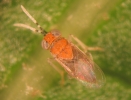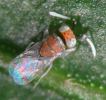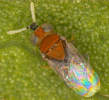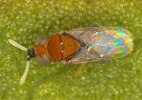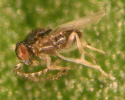 |
Scientific nameAnagyrus dactylopii (Howard) (=Anagyrus citri Agarwal, A. scutomaculatus Agarwal)
Taxonomic positionHymenoptera: Encyrtidae: Tetracneminae
DiagnosisFemale: Length: 1.4-1.6 mm. Head, mesoscutum and scutellum orange-yellow, mesoscutum with a narrow dark brown band across its anterior margin, scutellum with a short, dull
brown longitudinal stripe in the middle. Antenna with scape, pedicel and anterior half of first funicular segment black to dark brown, other antennal segments white. Abdomen dark brown. Legs white. Head and dorsal side of thorax with fine reticulate sculpture. Marginal and postmarginal veins combined shorter than
stigmal vein. Ovipositor only slightly exserted.
Male: Length: 0.7-1.2 mm. Dorsal side more or less uniformly black to bluish brown, covered with fine silvery hairs, antennal scape basally white, black in posterior half, pedicel brown, remaining segments white with long, conspicuous whorls of curved setae, club terminally black; scale-like sensilla on 6th funicle segment and clava broad at apex. All pairs of legs more or less completely white. 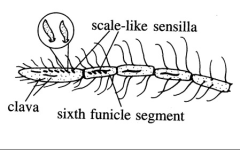 Antenna with scale-like sensilla on funicle VI Antenna with scale-like sensilla on funicle VIAnagyrus dactylopii is very closely related to A. pseudococci (Girault). A. dactylopii differs from the type material of A. pseudococci only in the relative width of the frontovertex and the entirely brown first segment of funicle. Based on examination of the type species, Noyes & Hayat (1994) opined that A. pseudococci is probably a geographical race of A.dactylopii. ImagesDistributionIndia: Andaman & Nicobar Islands; Andhra Pradesh; Bihar; Delhi; Goa; Himachal Pradesh; Karnataka; Kerala; Orissa; Punjab; Maharashtra; Tamil Nadu; Uttar Pradesh; Uttaranchal. Southeast Asia (Indonesia; Philippines; Taiwan; Thailand). China. Middle East. Hawaii (Noyes and Hayat, 1994; Hayat, 2006).
HostsFerrisia virgata (Cockerell), Maconellicoccus hirsutus (Green), Planococcus citri (Risso), Nipaecoccus viridis (Newstead), Dysmicoccus brevipes, Pseudococcus spp., Rastrococcus iceryoides, Saccharicoccus sacchari, Paratachardina sp., Pseudococcus sp., Rastrococcus cappariae, Drosicha stebbingi, and several other
species of mealybugs. (For complete list of hosts / associates from different parts of the world, refer to Noyes & Hayat, 1994; Hayat, 2006;
Universal
Chalcidoidea Database, and
Scalenet).
References
|
